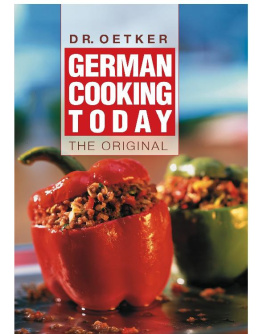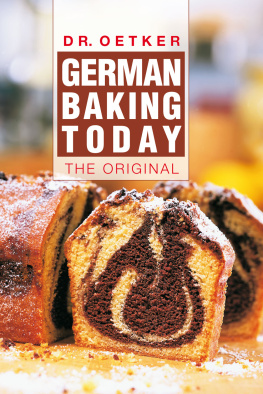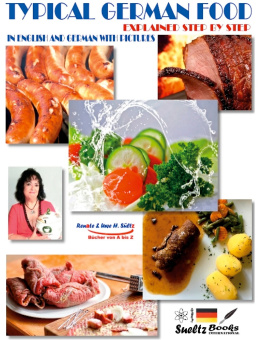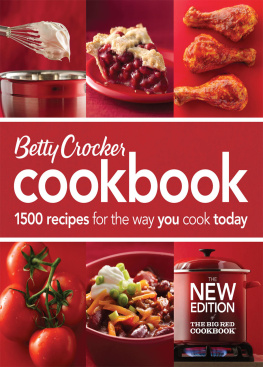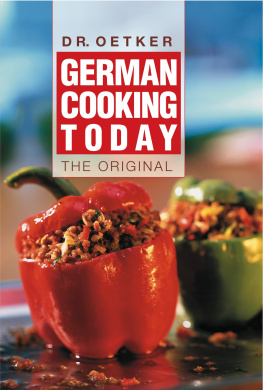
Foreword
German Cooking Today, the recognized standard work that has had a fixed place in many German households for generations, is now available in a new English edition after detailed revision.
With the precise, detailed instructions of these recipes, the book is exceptionally clear and user-friendly. In all, this will ensure that even the inexperienced cook will be certain of success in making the dishes.
As well as many new recipes that arise from peoples ever-changing eating habits, you will of course still find such popular German classics as Beef olives, Sauerbraten and Stuffed peppers in German Cooking Today.
All the recipes have been thoroughly tested and cooked in Dr. Oetkers test kitchen.
We wish you great pleasure with this book, every success in cooking the recipes and much enjoyment serving and eating the dishes.
Contents
Recipes 1-23
Recipes 24-31
Recipes 32-52
Recipes 53-61
Recipes 62-65
Recipes 66-78
Recipes 79-90
Recipes 91-114
Recipes 115-129
Recipes 130-150
Recipes 151-155
Recipes 156-164
Recipes 165-170
Recipes 171-189
General information about this book
Read recipe through completely before you start cooking, or even better before buying the ingredients. The various stages of the recipe and the method will often appear much clearer if you have read it through first.
Please look at the indications of quantities and spoon measurements on the inside covers of the book because they will be very useful when following a recipe.
Preparation time:
Preparation time refers to the time it takes to carry out the actual work preparing and making the dish. It does not include cooling down, marinating or soaking and waiting times.
Oven cooking times and oven temperatures:
The oven temperatures and oven cooking times indicated in the recipes are approximate values which can be reduced or increased depending on the individual heating performance of the oven, which varies, for instance, according to the material and design of the top and bottom heating elements. Therefore, please follow the manufacturers instructions when using the oven and check whether the food is done towards the end of the cooking time indicated in the recipe. When roasting meat, the use of a meat thermometer is recommended.
Serving sizes and nutritional values:
The quantities of most of the recipes are for 4 servings. Where the number of servings or pieces is different, this is stated in the recipes. The nutritional values given in the recipes refer to this serving size and are only valid for the quantities indicated; where there is a range of serving sizes, the calculation is based on the average size. The following abbreviations are used: P = protein, F = fat, C = carbohydrate.
Relevant information:
At the beginning of most sections you will find an extensive guide including general information and useful tips relating to the subject of the section. In addition, at the end of the book there is a general advice section about storing and processing food, cooking processes, cooking equipment, herbs and seasonings, and a list of cooking techniques.
Important note:
For dishes prepared with raw eggs that are also eaten raw, only use eggs that you know to be fresh. Store prepared food in the refrigerator and consume within 24 hours.
ADVICE
Soups
Soups are normally served as the first course of a menu, serving to stimulate the appetite and as a preparation for the dishes that follow.
The basis of a good soup is a strong, tasty stock. Stocks are made from bones, fish, beef, veal, poultry, game and vegetables. To round off the flavour, soup vegetables, a bouquet garni and/or a studded onion may be added.
Soup vegetables
These consist of equallysized pieces of leeks, celeriac, carrots and sometimes Hamburg parsley or a sprig of flat or curly-leaved parsley. These are also sold prepacked. The actual ingredients and weight used may vary according to the season. The standard amount is about 200300/710 oz, which is enough for 12 litres/1 pints (4 9 cups) of stock, but in some cases the selection may weigh up to 500 g/18 oz.
Bouquet garni for soup
This is a soup flavouring consisting of soup vegetables and herbs, for instance 12 sprigs thyme, 1 sprig lovage, 12 bay leaves and 1 sprig parsley. The bouquet garni ingredients are cleaned, washed and tied together with kitchen string, so that the bunch can easily be removed at the end of the cooking time.
Onion studded with bay leaf and cloves
The inedible outer skin of the onion is pulled off, then a diagonal cut about 2 cm/ in deep is made and 1 bay leaf is pushed into the slit. Then some cloves are pushed into the onion, sharp end first.
Making stock (broth)
1. Prepare the ingredients and put in a saucepan. (For a vegetable stock, the vegetables, cut into coarse dice, are sometimes first browned in hot cooking oil before the water is added. The browning process forms cooking products that give the stock a stronger flavour.)
2. Fill the pan with cold water to cover the ingredients and bring to the boil.
3. With a ladle, skim off the foam of coagulated protein and cloudy particles.
4. Add the soup vegetables only after skimming.
5. Reduce the heat and leave the ingredients to simmer uncovered over a low heat for at least 60 minutes.
6. Pour the finished stock through a fine sieve (perhaps a sieve lined with a cooking cloth) and use as directed in the recipe. If desired the half-cooked vegetables and meat or fish may be finely chopped and returned to the stock.
- Tips
- If the ingredients are put in cold water, their flavour is more strongly extracted so that the flavour of the stock becomes fuller and stronger.
- If the ingredients (particularly meat) are put directly into boiling water, the pores close up immediately, that is, less meat juice escapes into the stock and the meat remains juicier. This method is employed if the meat is intended for further use.
- Do not add salt to stock until is being used in a soup, because pre-salted stock tastes even saltier when it has been kept.
- Do not cook any dough, rice or dumplings in clear stock since they will make the stock cloudy. Such garnishes should be cooked separately.
- A more concentrated stock can be made by increasing the amount of meat added, browning the ingredients before adding the water, or by reducing the stock.
- Removing fat from the stock
- If the hot stock is to be used immediately, you can
- skim off the specks of fat with a large, flat spoon, or
- draw absorbent kitchen paper over the surface of the stock, so that the paper lifts off the layer of fat.
- If more time is available, let the stock cool down. The fat floating on the surface solidifies when it becomes cold and can then be easily lifted off with a large, flat spoon.
Freezing stock
Clear stock can be frozen, ideally in separate servings, (perhaps in ice cube trays), so that it is quickly available when required.
Instant products
If time is short, a commercial instant product such as bouillon powder or stock cubes may be used. The quantity to be used is given in the instructions on the packet. Another possibility is concentrated liquid stock, but this is quite expensive.
Cream soups
These are based on a stock thickened with a binding medium such as flour, starch, crme frache, vegetable pure, egg yolk or an egg yolk-cream mixture. Cream soups thickened with egg yolk, on its own or mixed, must not be brought to the boil after the yolk mixture has been added or the yolk will curdle.
Next page
